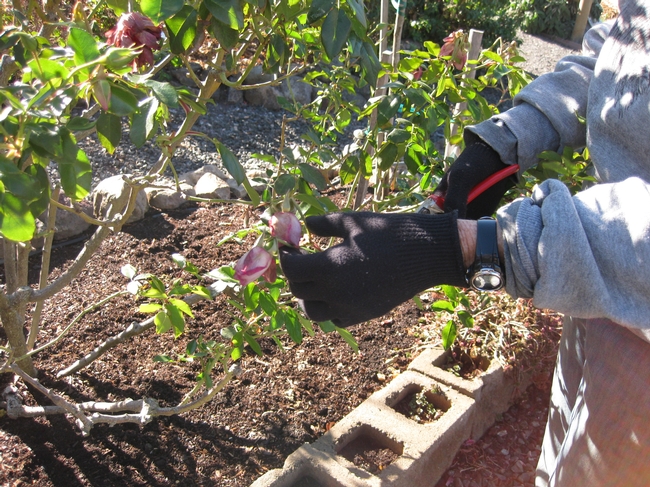
January is perfect for assessing your collection of saved seeds and making plans for the next round of gardening. If you enjoy starting your own vegetables and annual flowers, order seeds from catalogs now to get them before you need them, at the end of January or early February.
My least favorite winter task is watering, but in this dry winter, we must water to keep plants healthy. Vegetable gardens planted in the fall with winter greens, broccoli, onions and garlic will not thrive unless watered.
Water vegetables when the top one to two inches of soil have dried out, and moisten the soil to a depth of 8 to 12 inches. Perennial plants that grow and bloom in winter, which includes most native plants, will also need regular watering. Plants that go mostly dormant in winter, such as roses and fruit trees, still need some water to stay healthy. And frost-tender plants like citrus need to be kept well-hydrated to help them fend off frost damage.
In our climate, January is historically the coldest month. However, we can hope that we will not be repeating December’s run of below-freezing nights. Be sure to protect tender plants when frost threatens.
If the rains do come, expect an increase in weed growth. Control weeds while they are small, hoeing or pulling them out. Whenever possible, use mulches to control weeds and conserve soil moisture. If you use organic mulches, the material will break down over time and improve your soil.
Insect pests tend to be less of a problem in cold weather, but I noticed that aphids on my cauliflower and broccoli survived December’s frigid temperatures. Control these plant-sucking pests by spraying them off with water. Vegetables tolerate a few aphids, but these insects seem to multiply quickly if not addressed early.
Deciduous fruit trees should be dormant now, with all leaves gone. Now is the time to prune and shape them. First remove all broken, diseased or dead wood, then look at the tree from all sides and tackle pruning for shape and for fruit. Different types of fruit trees require different amounts of pruning, so consult a knowledgeable tree source if you do not know how much growth to remove.
Winter is also the time to spray fruit trees to control pests. Copper-based fungicides control fungal diseases such as peach leaf curl and powdery mildew. Spray on a dry, wind-free day and be sure to follow all precautions on the product label. Dormant oil sprays can help control insect pests such as scale and mites by smothering their eggs. Delay spraying until close to bud break in late winter or early spring.
Nurseries have a good supply of bare-root fruit and shade trees now. Bare-root trees are an economical way to add to your orchard or beautify your landscape. Keep the roots moist after purchase and plant as soon as possible. When preparing the planting hole, do not amend the native soil too much. Add no more than 25 percent compost to the soil that covers the roots to encourage the roots to dig deeper for nutrients. Plant the crown of the tree higher than the soil surface to allow for settling over time and to keep the crown from being inundated with moisture during rainy periods. Mulch well, keeping the mulch four to six inches away from the trunk to prevent crown rot.
Bare-root choices also include roses, ornamental vines, artichokes, strawberries and asparagus. As you would for bare-root trees, keep the crown of the plant at or above soil level when planting.
Any vegetables you planted in fall are probably growing slowly now, but check them often for maturity and harvest as ready. These might include lettuces, parsnips, beets, carrots, cabbages, broccoli and radishes. You can get an early start on the spring planting season by sowing seeds now for kale, parsley, radishes and spinach. These crops can be direct-sown outdoors, while the brassicas (broccoli, cabbage, cauliflower) should be started indoors for transplanting next month.
Enjoy the slower pace of January gardening. And if you have any influence with the weather gods, have them send us some rain.
Workshop: Join Napa County Master Gardeners for a workshop on “Rose Pruning” on Saturday, January 18, from 10 a.m. to noon, at the University of California Cooperative Extension (address below). January is the best time to prune your roses. Come learn pruning techniques from a certified Rosarian. Bring your rose questions. Online registration (credit card only).Mail-in registration (cash or check only).
Napa County Master Gardeners welcome the public to visit their demonstration garden at Connolly Ranch on Thursdays, from 11:00 a.m. until 1 p.m., except the last Thursday of the month. Connolly Ranch is at 3141 Browns Valley Road at Thompson Avenue in Napa. Enter on Thompson Avenue.
Master Gardeners are volunteers who help the University of California reach the gardening public with home gardening information. Napa County Master Gardeners ( http://ucanr.org/ucmgnapa/) are available to answer gardening questions in person or by phone, Monday, Wednesday and Friday, 9 a.m. to Noon, at the U. C. Cooperative Extension office, 1710 Soscol Avenue, Suite 4, Napa, 707-253-4143, or from outside City of Napa toll-free at 877-279-3065. Or e-mail your garden questions by following the guidelines on our web site. Click on Napa, then on Have Garden Questions? Find us on Facebook under UC Master Gardeners of Napa County.